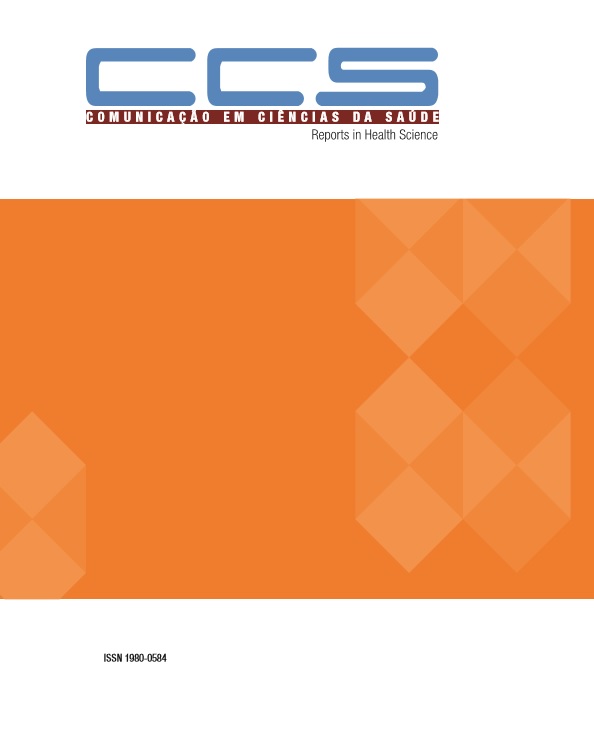Rabdomiólise após uso de ácido tranexâmico em paciente portador de angioedema familiar
DOI:
https://doi.org/10.51723/ccs.v30i03.456Palavras-chave:
Angioedema hereditário, Ácido tranexâmico, RaddomióliseResumo
O angioedema familiar, desordem genética com produção exacerbada de bradicinina e edema generalizado, tem sintomas diversos que surgem sem nenhum fator causal. O tratamento consiste no uso de medicações de resgate durante as crises e na profilaxia a curto e longo prazo. Objetivo: relatar o caso de um paciente tratado com ácido tranexâmico, um agente antifibrinolítico, que apresentou elevação de ureia, creatinina e creatina fosfoquinase, recebendo o diagnóstico de injúria renal aguda por rabdomiólise. Após suspensão do medicamento, melhorou a função renal e diminuiu a enzima. Conclusão: a rabdomiólise é um efeito descrito com o uso do ácido épsilon-aminocaproico, mas não do ácido tranexâmico.
Downloads
Referências
Ferraro MF, Ferriani MPL, França AT, Fusaro G, Garcia JFB, Komninakis S, et al. Diretrizes brasileiras para o diagnóstico e tratamento do angioedema hereditário – 2017. Arq Asma, Alerg e Imunol. 2017;1:23–48.
Bork K, Meng G, Staubach P, Hardt J. Hereditary Angioedema : New Findings Concerning Symptoms , Affected Organs , and Course. Am J Med. 2006;119:267–74.
Kanani A, Betschel SD, Warrington R. Urticaria and angioedema. Allergy, Asthma Clin Immunol [Internet]. 2018;14(s2):1–13. Available from: https://doi.org/10.1186/s13223-018-0288-z
Lumry WR. Current and Emerging Therapies to Prevent Hereditary Angioedema Attacks. Am J Manag Care. 2017;24(14):299–307.
Maurer M, Maferl M, Ansotegui I, Aygoren-Pursun E, Betschel S, Bork K, et al. The international WAO / EAACI guideline for the management of hereditary angioedema — The 2017 revision and update. Eur J Allergy Clin Immunol. 2018;73(December 2017):1575–96.
Martins S, Salgado M, Raposo F, Pinto D, Martinho I, Araújo R. Angioedema recorrente – caso clínico. Rev Pediatr do Cent Hosp do Porto. 2014;XXIII(1):21–4.
Valle SOR, França AT, Campos RA, Grumach AS. Angioedema hereditário. Rev bras alerg imunopatol. 2010;33(3):80–7.
Cabral GG, Monice LM, Machado LRD, Caldeira LML, Silva LR e, Couto H de A. Insuficiência renal aguda devido à rabdomiólise. Acta Biomed Bras. 2012;3(2):42–7.
Dunn CJ, Goa KL. A Review of its Use in Surgery and Other Indications. ADIS DRUG Eval. 1999;57(6):1005–32.
Neto MP, Gonçalves RV, Machado CJ, Resende V. Fatores associados à variação da creatina fosfoquinase (CPK) em pacientes vítimas de trauma, submetidos à “Onda Vermelha”, com evolução à rabdomiólise. Rev Col Bras Cir. 2018;45(2):1–9.
Downloads
Publicado
Edição
Seção
Licença
Declaro para os devidos fins que o artigo que estou submetendo representa um trabalho original e nunca foi publicado total ou parcialmente, e que se alguma de suas partes foi publicada possuímos autorização expressa para a publicação no periódico Comunicação em Ciências da Saúde (CCS). Esse artigo não foi enviado a outro periódico e não o será enquanto estiver sendo considerada sua publicação; caso venha a ser aceito não será publicado em outro periódico; e não contém material difamatório ou ilegal sob nenhuma forma, não viola a intimidade de terceiros, nem infringe direitos protegidos.
Eu e demais autores desse trabalho certificamos por meio desta declaração que:
- Concordamos com as normas editoriais e com o processo de revisão da CCS;
- Aceitamos a responsabilidade pela conduta desse estudo e pela análise e interpretação dos dados;
- Cooperaremos, sempre que solicitado, na obtenção e fornecimento de dados sobre os quais o manuscrito está baseado, para exame dos avaliadores;
- Não estão sendo omitidos quaisquer ligações ou acordos de financiamento entre os autores e companhias ou pessoas que possam ter interesse no material abordado no artigo;
- Não estão sendo excluídos ou omitidos deste artigo autores ou instituições participantes;
- Possuímos permissão para uso de figuras e tabelas publicadas em outras fontes;
- Possuímos permissão das pessoas e instituições citadas nos agradecimentos;
- O autor correspondente autoriza a publicação do endereço informado e e-mail do(s) autor(es) junto com o artigo;
- Assumimos a responsabilidade pela entrega de documentos verídicos;
- Autorizamos a publicação do referido artigo no periódico Comunicação em Ciências da Saúde, segundo critérios próprios e em número e volume a serem definidos pelo editor do periódico;
- Nos comprometemos a atender os prazos estipulados pelos editores do periódico Comunicação em Ciências da saúde;
- Estamos cientes de que a não manifestação no prazo de dois dias da revisão da diagramação, recebida por e-mail, será considerado aprovado para publicação.








